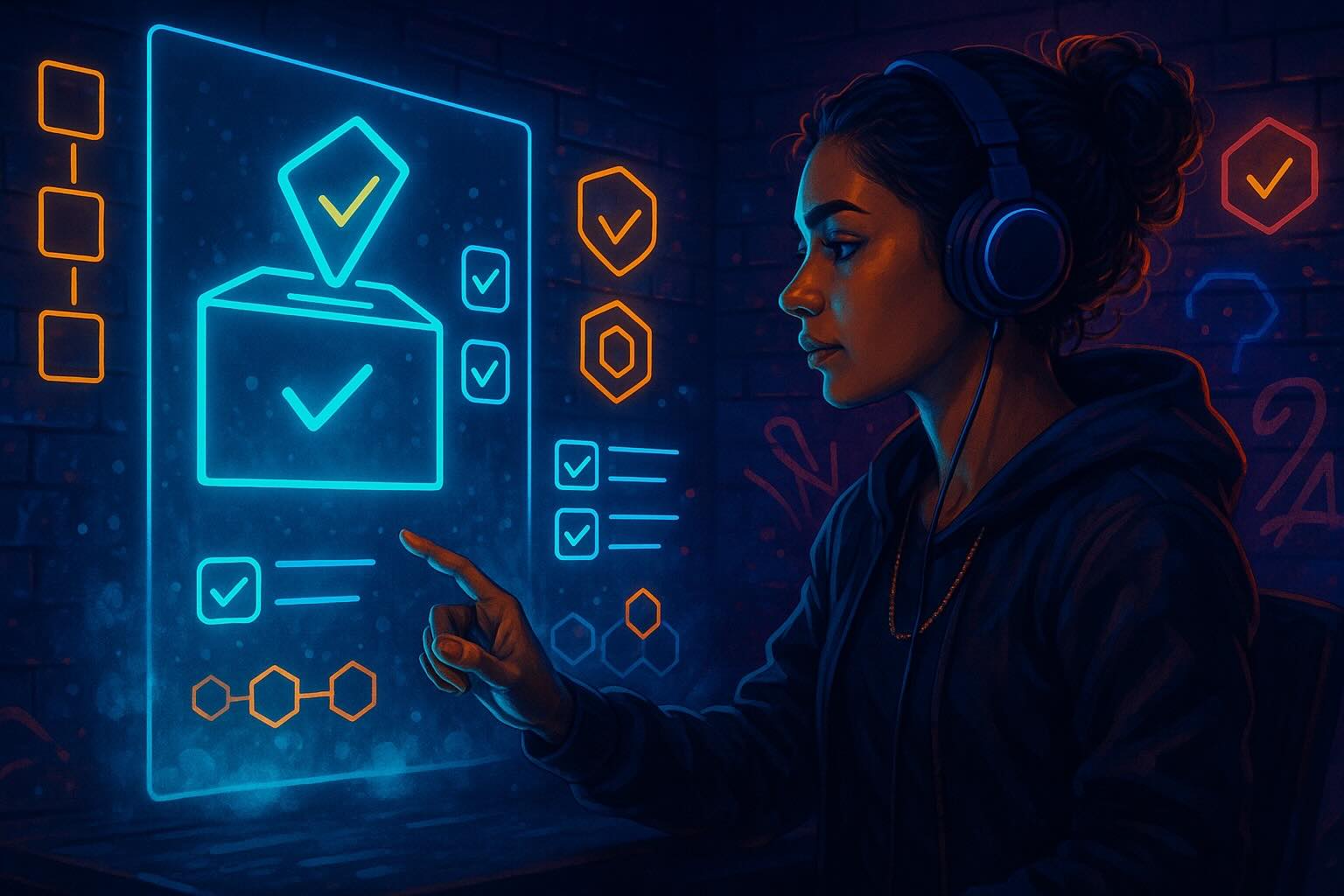A fresh look at voting, democracy, and the system behind your ballot.

Let's begin.
Trust doesn’t announce itself.
It’s there when you pick up a prescription and assume the dosage is right.
When you read a birth certificate and don’t question its origin.
When you vote, and expect that the result reflects the will — not the system.
These everyday interactions aren’t trivial. They are where our belief in society either holds or fractures.
And more often now, it fractures.
Behind each system we rely on — from medical records to elections — is an architecture built on assumptions. That data won’t be altered. That results won’t be manipulated. That systems won’t serve those in power more than the people inside them.
What happens when those assumptions no longer feel safe?
This is the question blockchain forces us to confront.
Not with utopian promises, but with structural alternatives.
To begin, we step into lived experience.
Why we follow her — and what she shows us.
Lucia isn’t a trader. She’s not a developer. And she’s never written a smart contract.
But she votes. She signs forms. She gets her prescriptions, pays her bills, and checks her savings.
Lucia lives in a system — like all of us — where trust is invisible until it breaks.
She doesn’t talk about “blockchain” over dinner. She talks about getting an appointment that matters, proving she’s eligible for help, or tracking where her money goes.
That’s why we follow her.
Because what blockchain can fix — and what it can’t — only becomes clear when you walk through everyday life. Not speculation. Not hype. Daily decisions. Quiet systems. Personal friction.
Lucia won’t give you trading advice.
She’ll show you where the system leaks — and what it might feel like if it didn’t.
So when you meet her again in these pieces — in the ballot booth, in the hospital line, in the crowd of a market — remember:
You’re not here to observe.
You’re here to recognize what’s already around you — and ask if it still holds.
Voting, at its essence, is an agreement: the system offers you a voice, and in return, you participate in shaping the future.
But in many cases, this agreement is uneven. Votes vanish into proprietary software. Counting occurs behind closed doors. Disputes are mediated by the same institutions accused of failure.
Blockchain reframes this entirely.
It takes the vote — the most elemental act in a democracy — and gives it permanence. Each ballot becomes a cryptographic transaction. It is time-stamped, confirmed across a decentralized network, and stored immutably. The record is no longer a promise — it is a fact, confirmed by consensus rather than controlled by an authority.
In this system, no single entity holds power over the outcome.
And no amount of political pressure can rewrite the past.
The vote becomes what it was always meant to be: irreversible, anonymous, and real.
Historically, we’ve accepted a compromise: that transparency comes at the cost of privacy, and that anonymity requires trust in a middleman.
Blockchain breaks this binary.
Through cryptographic verification and decentralized consensus, blockchain allows votes to remain anonymous while still being publicly auditable. No individual’s identity is exposed, yet every vote can be traced back to a moment in time — confirmed, immutable, and beyond tampering.
This isn’t a theoretical benefit. In regions where surveillance is weaponized and dissent punished, the ability to vote without fear is not just protective — it is foundational.
A system that can verify truth while shielding the individual is no longer a luxury. It is a human necessity.
If this sounds promising, it’s because it is. But it’s not without limits.
Public blockchains like Ethereum were not built to handle millions of transactions in real time. Election-scale data loads create bottlenecks, drive up costs, and slow down finality — all of which threaten the credibility of a vote.
Enter Layer 2.
Layer 2 protocols — fast, scalable extensions to blockchain networks — are designed to relieve this pressure. They process transactions off-chain, bundle them, and post results back to the main chain — reducing cost and increasing speed without compromising security.
It’s not a shortcut. It’s an evolution.
This is what makes blockchain viable not just as a theoretical model, but as a global infrastructure — one that can handle the weight of public participation.
It’s easy to see blockchain as a technological fix for already-functioning systems.
But its real power lies elsewhere — in the margins.
In states where elections are rigged before they begin.
Where ballot boxes are burned.
Where turnout is high, but hope is low.
Lucia doesn’t fear surveillance. But she knows people who do.
For these communities, blockchain is more than a tool. It’s a form of protection.
Votes cast in fear are still votes. But without safeguards, they disappear — or worse, they backfire.
When votes are encrypted, anonymous, and distributed across a network, intimidation loses its leverage. Tampering becomes traceable. And democracy gains a form of resilience it never had before.
This is not an abstract benefit. It is survival, encoded.
In the end, this is not just about elections. It’s about architecture.
It’s about systems that don’t require belief to function.
About outcomes that don’t depend on who counts the votes — because they’re already counted, publicly, permanently, and correctly.
Blockchain offers no promises. It doesn’t pretend to fix democracy with code.
What it offers is clarity.
And in a world where faith in institutions is eroding, clarity is power.
Not because it comforts us — but because it lets us finally see what’s real.